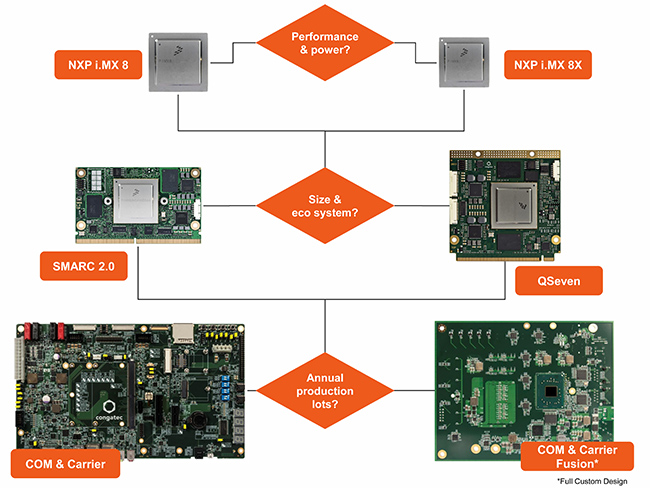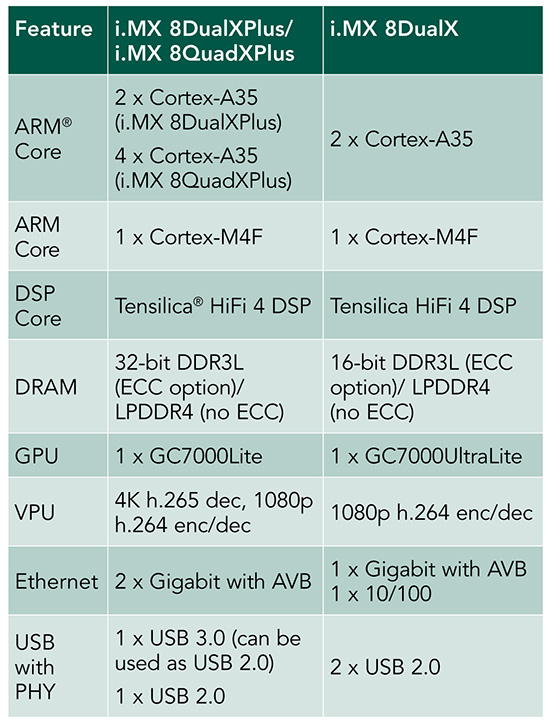Lower power computing with Arm
The modules featuring NXP i.MX 8 multi-core 32- and 64-bit ARM processors, which congatec offers in the SMARC 2.0 and Qseven standards, are robust and some are designed for the extended temperature range from -40°C to +85°C. They are predestined for a wide range of applications and even allow full solar operation with an energy consumption of less than 3-5W during normal operation. Here congatec discusses the potential industrial applications.
Since processors of the i.MX 8 family come in a wide variety of configurations and performance classes, the application areas are also extremely diverse. They range from smaller industrial control and automation systems such as PLCs, I/O controllers, robotic and handling systems, building management systems, IoT and M2M applications with distributed devices of various designs, to automotive and intralogistics cockpits or distributed smart video surveillance systems.
Even if these devices are equipped with the most economical 3W processors of the i.MX 8X series, they offer significantly more performance than what was considered top of the range for tablets only a few years ago. Besides, they are also becoming increasingly attractive in terms of price, so that they are opening up more and more application fields and markets.
The integrated image processing functions further predestine the new processors for video analytics and the use of neural network technology for object recognition and situational awareness applications, for example in collaborative robotics. However, which processors are recommended for industrial use? A look at the processor selection of embedded computer board and module manufacturers can help.
The most important NXP processors
congatec has initially focused on two processor classes of the i.MX 8 family, since both the i.MX 8 – in the QuadMax, QuadPlus and Dual versions – as well as the i.MX 8X were developed end-to-end for industrial applications and therefore also support the important, low-cost LVDS connection for integrated displays. It is precisely for this reason that the company currently doesn’t support the i.MX 8M, which is already available in series but lacks LVDS support. In addition, this variant has been developed for consumer set-top boxes and TV systems, which makes support more difficult for industrial applications. So what are the differences between i.MX 8 and i.MX 8X?
What's the difference?
As a flagship processor, the new NXP i.MX 8 (Quadmax) processor has long enjoyed embedded system developers’ attention. It is the most powerful of the entire i.MX 8 family and extends into the application fields of previous low-power x86 processors. This means it can replace existing designs in this category, which can provide TPD and price advantages when purchasing processors.
Next to it, the new i.MX 8X processor family is now also becoming available. It expands the scalable spectrum of the i.MX 8 series by adding a particularly energy saving and robust processor variant, which opens additional application fields for very small smart devices with full application flexibility thanks to open operating system support.
Slim but secure
The main differences between the i.MX 8X and the i.MX 8 (Quadmax) lie in the former using ARM Cortex A35 cores instead of up to four ARM Cortex A53 cores, and the elimination of ARM Cortex A72 cores. In addition, the i.MX 8X has one instead of two Cortex M4F with integrated floating point unit and DSP for processing critical tasks such as fallback camera, system monitoring and system wake-up. It also offers a more economical and energy efficient feature set. This reduces the energy consumption of the i.MX 8X to 3-4W, compared to 12W for the fully equipped i.MX 8, which provides a total of up to 8 cores (4x A53, 2x A72, 2x M4F).
The small i.MX 8X nevertheless offers an in depth feature set including high bandwidth and low-power LPDDR4. The i.MX 8 supports up to three independent displays as well as 1x SPDIF and 2x ASRC sound including comprehensive codecs for speech recognition and contactless interaction. Two displays can be connected in Full HD (1,080p) and another in WVGA (864x480). The integrated video processing engine supports decoding and encoding of 1,080p videos in h.264 as well as decoding of even higher resolution 4K videos in h.265. Another important feature is hardware-based resource partitioning - allowing the separation of processor as well as graphics cores, it makes it possible to operate multiple independent applications on a single chip. In combination with hypervisor support, highly flexible fail-safe systems can be developed – an important feature for autonomous robotics vehicles, among others. For example, if the 3D camera system fails, a camera remains fail-safe in B/W mode. Of course, the same principle can also be applied to other vision-based controls in automation technology.
Many interfaces
As for interfaces, the core offers 1 PCIe 3.0 for flexible expansion options as well as 1x USB 3.0, 2x USB 2.0, 3x CAN, 4x UART, 4x SPI and 1x 12 bit AD converter. Further provided are 2x Gigabit Ethernet interfaces that are well suited for horizontal and vertical networking in automation. Optional support for 1588-compliant real-time communication via the TSN protocol ensures the core is ready for Industry 4.0 and IoT, making it possible to synchronise several welding robots/arms in a production cell in real-time via Ethernet. In case of the i.MX 8X, this support can be realised by using an additional Qualcomm Atheros device, an option that’s available for congatec modules. Audio video bridging (AVB) is also supported for video streaming via Ethernet, which can be of interest for monitoring and quality control with GbE cameras, because a point-to-point connection is no longer required and multiple video channels can be transmitted in duplex mode.

Above: congatec offers both the i. MX 8 and the i.MX 8X on SMARC 2.0 and Qseven modules. Customer-specific carrier boards and full-custom designs are also available
Image recognition and deep learning
For video-based applications, the i.MX 8X supports a 4-lane MIPI-CSI interface, among others. The GPUs with 2-4 Vec4 shaders (1x GC7000Lite or 1 x GC7000UltraLite) also support OpenGL ES, OpenCL, OpenVG and Vulkan for parallel data processing besides the graphics output. The focus is on situational awareness applications with image recognition as well as AI and deep learning applications for machine learning. If you’re missing something from this extensive feature set of the i.MX 8X, you can safely assume that the i.MX 8, as the bigger version, will offer more in every feature category.
Reliability with multiple security features
Overall, both processor variants also provide greater reliability, which is a result of employing fully-depleted silicon-on-insulator (FD-SOI) manufacturing technology. Compared to previous technologies, it helps application processors manufactured in the 28nm process to drastically improve MTBF and to reduce latch-ups thanks to the high immunity of FD-SOI to soft defects. All these functions, together with sophisticated security features such as high assurance boot, TPM timer, comprehensive encryption, and up to ten active and passive tamper pins, make the new i.MX 8 processors an ideal basis for the development of extremely energy efficient and highly reliable embedded computing platforms for the automation industry.
Computer-on-modules provide high investment protection
congatec offers all these i.MX 8 processors as application-ready SMARC 2.0 and Qseven modules for immediate series production. However, the fact that the modules are application ready – which saves on NRE costs, not least because companies like congatec also offer suitable hardware related software services which makes integration even easier – is not the only advantage.

Above: SMARC 2.0 and QSeven modules with i.MX 8X processor come in three different variants
They also provide a roadmap for long-term availability that is not even limited by the processor architecture since these module standards also support all low-power x86 processors. And that’s a good thing, because with increasing processing performance, the question of whether the ARM or x86 instruction set is more efficient or not has become virtually irrelevant. This is because there is so much glue logic programmed into modern and thus hardware independent application codes that the actual application functions are becoming increasingly independent of the pure hardware.
Even with soft PLCs or, for example, Java-based GUI software. More and more development frameworks and run-time tools now also support both architectures, as well as Linux, of course. Even an Android x86 is available.
Standardisation helps - even with Arm designs
And yet, you can’t just go and install software on one or the other platform and expect that everything will run like clockwork. The crux is often in the detail. Not least because the experts are either ARM or x86 hardware specialists. Depending on the supplier, the API design for specific board configurations can also vary widely. It’s a completely different case with standardised SMARC 2.0 and Qseven modules. They have – at least at congatec – functionally identical APIs and provide a homogeneous set of drivers and libraries according to the PICMG form factor and embedded API specifications.
They also enable extremely simple platform changes, in physical terms alone. On existing carrier boards, only the relevant module needs to be changed. Anyone who designs industrial computers in the low-power segment should therefore consider implementing Computer-on-Modules based on the leading standards. They give developers extreme security on the processor side, and whatever is hosted on the carrier board of these modules can always be designed to the exact needs of the application. What more could you ask for?


